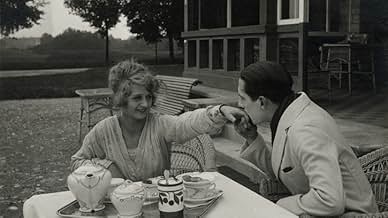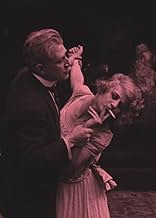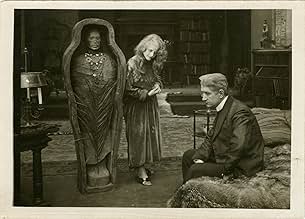Adicionar um enredo no seu idiomaA Parisian museum director believes his wife has lost interest in him and so places a poisoned cigarette in the box on his desk - thus allowing chance to decide the moment of his death.A Parisian museum director believes his wife has lost interest in him and so places a poisoned cigarette in the box on his desk - thus allowing chance to decide the moment of his death.A Parisian museum director believes his wife has lost interest in him and so places a poisoned cigarette in the box on his desk - thus allowing chance to decide the moment of his death.
- Direção
- Roteirista
- Artistas
Avaliações em destaque
This film is only watched because the woman who directed it went on to greater things. The print is terrible, with dramatic dropouts (probably beyond repair). It tells the story of a fifty something museum curator who has married a pretty young woman. She is affectionate and loving (and we would say he is a lucky man). She is also full of life and he is terribly stuffy and directs his energy toward mummies and old things. When she takes a bit of a shine to a younger man, he becomes jealous. There is nothing to it, but the old guy is so jealous that he decides to kill himself and release her from their marriage. He decides to poison some cigarettes (how is that for weird?) and slink into oblivion. I won't spoil things by revealing the ending. Watch this only if you are a bit of a film buff because of the horrible quality of the film.
Germaine Dulac's earliest surviving feature -- albeit in an erratically chipped copy -- is a story about the old man Gabriel Signoret (41, albeit in a white wig) married to a young woman, Andrée Brabant. He's an archeologist working on a new display of the mummy of a young Egyptian princess whose elderly husband grew jealous and had her killed with a poisoned seedcake. Signoret grows suspicious that Mlle Brabant is carrying on with Jules Raucourt, whose twin professions are dancing and golf. Determined to kill himself, he poisons a cigarette, puts it in his case, and writes a note to be discovered after he uses it at random. Immediately people start bumming smokes off him, including the innocent missus.
I first encountered Mme. Dulac's movies in the winter of 2003-2004, when a program of them played at New York's Museum of Modern Art. Each film was preceded by a lecture by an earnest young woman. Reading from notes, at each showing she informed the audience that Dulac was a Lesbian and a woman, and that was why she was an important film maker. I preferred to look at the movies instead of being told they were important. I discovered she was a highly competent film maker whose male characters behaved stupidly, often selfishly, occasionally villainously. Viewed as a corrective to the vamp movie, it might be considered turnabout in fair play. However, she had a propensity for dragging out the big scene past my patience. In short, I found her movies tiresome.
Perhaps it is bumptious of me, but this one strikes me as more of the same. Dulac fills the screen with images of Mlle Brabant's innocence. She kisses white doves around the house's fountain. She plays with a white dog. She is vivacious and flirty, but she's fond of the old fellow, little though he deserves it. Just like all men.
I first encountered Mme. Dulac's movies in the winter of 2003-2004, when a program of them played at New York's Museum of Modern Art. Each film was preceded by a lecture by an earnest young woman. Reading from notes, at each showing she informed the audience that Dulac was a Lesbian and a woman, and that was why she was an important film maker. I preferred to look at the movies instead of being told they were important. I discovered she was a highly competent film maker whose male characters behaved stupidly, often selfishly, occasionally villainously. Viewed as a corrective to the vamp movie, it might be considered turnabout in fair play. However, she had a propensity for dragging out the big scene past my patience. In short, I found her movies tiresome.
Perhaps it is bumptious of me, but this one strikes me as more of the same. Dulac fills the screen with images of Mlle Brabant's innocence. She kisses white doves around the house's fountain. She plays with a white dog. She is vivacious and flirty, but she's fond of the old fellow, little though he deserves it. Just like all men.
La cigarette (1919)
*** (out of 4)
Pierre (Gabriel Signoret) is an older man who works as a museum director and is also married to the much younger Denise (Andree Brabant). Before long Pierre starts to believe that she's having an affair with a famous tennis player so he's influenced by the story connected to a mummy at his museum. Pierre plans to poison one of his cigarettes and then add it to a bunch where he never knows when he will die.
This film was directed by Germaine Dulac, a French woman who worked as a critic, a poet and she also made a handful of films. I had never heard of this film until it turned up in a box set of movies directed by females and I must say that while the movie had some flaws it also had a pretty interesting idea and it made for a very entertaining movie and one that deserves to be better known than it is.
What I liked most about this film was the story itself. I thought the whole angle with the mummy and its story was interesting and I liked the story around a man wanting to kill himself but not know when. Adding one poisonous cigarette to dozens of them and then just smoking them at will was a good concept. Of course, I think the film would have been even better had they tried to bring some tension out of this scenario.
With that said, the film was extremely well-made and I like the touches that Dulac brought to it and especially how the old man story was told. Both Signoret and Brabant were very good in their roles and the film was fast-paced for its 51-minutes. Fans of silent cinema will certainly want to check this one out.
*** (out of 4)
Pierre (Gabriel Signoret) is an older man who works as a museum director and is also married to the much younger Denise (Andree Brabant). Before long Pierre starts to believe that she's having an affair with a famous tennis player so he's influenced by the story connected to a mummy at his museum. Pierre plans to poison one of his cigarettes and then add it to a bunch where he never knows when he will die.
This film was directed by Germaine Dulac, a French woman who worked as a critic, a poet and she also made a handful of films. I had never heard of this film until it turned up in a box set of movies directed by females and I must say that while the movie had some flaws it also had a pretty interesting idea and it made for a very entertaining movie and one that deserves to be better known than it is.
What I liked most about this film was the story itself. I thought the whole angle with the mummy and its story was interesting and I liked the story around a man wanting to kill himself but not know when. Adding one poisonous cigarette to dozens of them and then just smoking them at will was a good concept. Of course, I think the film would have been even better had they tried to bring some tension out of this scenario.
With that said, the film was extremely well-made and I like the touches that Dulac brought to it and especially how the old man story was told. Both Signoret and Brabant were very good in their roles and the film was fast-paced for its 51-minutes. Fans of silent cinema will certainly want to check this one out.
This film was aired on TCM in December 2020 as part of the Women Make Film lineup, as the director is a woman. I mostly enjoyed the film, but was distracted by the amount of damage that obscured the action, and the title cards, which were extensive and long, as well as all in French. I got the general idea of the plot, but missed out on the finer details, such as what the Egyptian mummy he brings home and puts in the bedroom has to do with anything. The variety of tinting was very nice, the parts of the film that were not damaged were very fine.
The story is engrossing, what I could gather from the action, not being able to read the title cards. The older husband is very busy with his Egyptian relics, and doesn't find time to spend with his younger wife, though the scenes with them together tend to show great affection between the two. We see her wandering around the house and grounds after being rebuffed by her distracted husband, which leads her to amuse herself outside of the house. She is flirted with by a young and handsome golf pro, but it never goes any further. However, her husband does find enough time to follow her around and he sees something that he mistook as what appeared to be a clandestine meeting between his wife and the golfer. Deciding to kill himself by mixing a poisoned cigarette in his full box to make death random, we see a servant sneak a smoke, and various other people, including his wife, try to take a cigarette out of the box which he vigorously prevents. All works out in an unusual way in the end. If you can read French, I would recommend this movie, otherwise, it may be tedious for some to figure out what's going on.
The story is engrossing, what I could gather from the action, not being able to read the title cards. The older husband is very busy with his Egyptian relics, and doesn't find time to spend with his younger wife, though the scenes with them together tend to show great affection between the two. We see her wandering around the house and grounds after being rebuffed by her distracted husband, which leads her to amuse herself outside of the house. She is flirted with by a young and handsome golf pro, but it never goes any further. However, her husband does find enough time to follow her around and he sees something that he mistook as what appeared to be a clandestine meeting between his wife and the golfer. Deciding to kill himself by mixing a poisoned cigarette in his full box to make death random, we see a servant sneak a smoke, and various other people, including his wife, try to take a cigarette out of the box which he vigorously prevents. All works out in an unusual way in the end. If you can read French, I would recommend this movie, otherwise, it may be tedious for some to figure out what's going on.
Let's be honest - those interested in the work of Germaine Dulac have probably only seen 1928's surrealist masterpiece La Coquille et le Clergyman (The Seashell and the Clergyman). I have only been fortunate enough to see 3 of her films and The Cigarette, while being her earliest surviving film, really does not have much to recommend it other than that trivial designation. Like many early silents, the pace is slow, the story slight and the picture quality is extremely poor. I'd say a good 20% of this film is so damaged and eroded that it is almost impossible to see what is going on. But it hardly matters as the story is fairly easy to follow even with occasion degraded images. If you're really interested in Dulac for her feminist stance, see 1923's La Souriante Madame Beudet (The Smiling Madame Beudet). Or if you want to see her true surrealist masterpiece see La Coquille et le Clergyman. But this film is really for completists only. Oh - and if you happen to see this and are befuddled by the French title cards, try turning on Closed Captioning; the version I saw had the title cards translated into English with CC on.
Você sabia?
- CuriosidadesThe earliest surviving film of pioneering feminist filmmaker Germaine Dulac.
- Erros de gravaçãoWhen Denise relates to Pierre her switching of the cigarettes in the box, the flashback shows her closing the box after filling it with the new cigarettes obtained from a cabinet. She then closes the cabinet door and returns to Pierre's office, where she is then holding an open cigarette box, which she closes again.
- Citações
Pierre Guérande: What's the use of struggling against such youth?
Principais escolhas
Faça login para avaliar e ver a lista de recomendações personalizadas
Detalhes
- Tempo de duração51 minutos
- Cor
- Mixagem de som
- Proporção
- 1.37 : 1
Contribua para esta página
Sugerir uma alteração ou adicionar conteúdo ausente






















